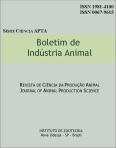Forage plants adaptation in the Ribeira Valley region of São Paulo State, Brazil. I. Location of Sete Barras
Abstract
A competition trial for dry matter and crude protein production, at the Ribeira Valey, State of São Paulo, Brazil, was conducted with 10 tropical legumes and 15 tropical grasses. The forage plants were submitted to two situations: fertilized and not fertilized. It was determined also the crude protein, crude fiber, potassium, calcium, and phosphorus contents in the dry matter. The best forages for dry matter and protein production were Pennisetum purpureum Schum cv. Napier and Taiwan A-1 14, Pannicum maximum Jacq. cv. Colonio, Setaria sphacelata Stapf. ex. Massey Irabo-de-cachorrol, Echinochloa pyramidalis, Hitch , Glycine wightii cv. Cianova, Ceatrosema pubescens, Benth,Pueraria phaseoloides (Roxb. 1 Benth e Galactia striata. (Jacq.) Urb. Diseases and insects attack occurred in several plants. The chemical determinations of the forage plants are discussed in the text.Downloads
Downloads
Published
Issue
Section
License
Os autores não serão remunerados pela publicação de trabalhos, pois devem abrir mão de seus direitos autorais em favor deste periódico. Por outro lado, os autores ficam autorizados a publicar seus artigos, simultaneamente, em repositórios da instituição de sua origem, desde que citada a fonte da publicação original seja Boletim de Indústria Animal. A revista se reserva o direito de efetuar, nos originais, alterações de ordem normativa, ortográfica e gramatical, com vistas a manter o padrão culto da língua e a credibilidade do veículo. Respeitará, no entanto, o estilo de escrever dos autores. Alterações, correções ou sugestões de ordem conceitual serão encaminhadas aos autores, quando necessário. Nesses casos, os artigos, depois de adequados, deverão ser submetidos a nova apreciação. As opiniões emitidas pelos autores dos artigos são de sua exclusiva responsabilidade. Todo o conteúdo deste periódico, exceto onde está identificado, está licenciado sob a Licença Creative Commons Attribution (CC-BY-NC). A condição BY implica que os licenciados podem copiar, distribuir, exibir e executar a obra e fazer trabalhos derivados com base em que só se dão o autor ou licenciante os créditos na forma especificada por estes. A cláusula NC significa que os licenciados podem copiar, distribuir, exibir e executar a obra e fazer trabalhos derivados com base apenas para fins não comerciais.













